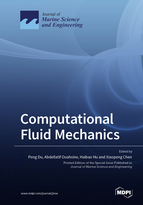Computational Fluid Mechanics
A special issue of Journal of Marine Science and Engineering (ISSN 2077-1312). This special issue belongs to the section "Ocean Engineering".
Deadline for manuscript submissions: closed (20 July 2022) | Viewed by 30803
Special Issue Editors
Interests: hydrodynamics; flow control; flow perception; CFD
Special Issues, Collections and Topics in MDPI journals
Interests: hydrodynamics; fluid-structure interaction; computational fluid mechanics; environmental fluid mechanics; coastal engineering; ocean engineering
Special Issues, Collections and Topics in MDPI journals
Interests: drag reduction; flow control; marine engineering
Special Issues, Collections and Topics in MDPI journals
Interests: multiphase flow; bubbles; Lattice Boltzmann Method
Special Issues, Collections and Topics in MDPI journals
Special Issue Information
Dear Colleagues,
Ocean flows and their interactions with marine structures, vehicles, etc. are of great importance for research in marine science and technology. Revealing their mechanisms inevitably involves fluid mechanics. Computational fluid mechanics (CFD) techniques are developing to a higher level today with the flourishing of computer science. CFD is able to predict ocean flow details and hydrodynamic interactions with increasing accuracy.
This Special Issue will collect papers on cutting-edge developments in CFD in the area of marine science and technology. CFD methods including novel numerical algorithms, advanced treatments of solving procedures, parallel acceleration techniques, and the utilization of CFD for fluid–structure interaction, wave modeling, ship dynamics, etc. are all welcomed.
Prof. Dr. Peng Du
Prof. Dr. Abdellatif Ouahsine
Prof. Dr. Haibao Hu
Prof. Dr. Xiaopeng Chen
Guest Editors
Manuscript Submission Information
Manuscripts should be submitted online at www.mdpi.com by registering and logging in to this website. Once you are registered, click here to go to the submission form. Manuscripts can be submitted until the deadline. All submissions that pass pre-check are peer-reviewed. Accepted papers will be published continuously in the journal (as soon as accepted) and will be listed together on the special issue website. Research articles, review articles as well as short communications are invited. For planned papers, a title and short abstract (about 100 words) can be sent to the Editorial Office for announcement on this website.
Submitted manuscripts should not have been published previously, nor be under consideration for publication elsewhere (except conference proceedings papers). All manuscripts are thoroughly refereed through a single-blind peer-review process. A guide for authors and other relevant information for submission of manuscripts is available on the Instructions for Authors page. Journal of Marine Science and Engineering is an international peer-reviewed open access monthly journal published by MDPI.
Please visit the Instructions for Authors page before submitting a manuscript. The Article Processing Charge (APC) for publication in this open access journal is 2600 CHF (Swiss Francs). Submitted papers should be well formatted and use good English. Authors may use MDPI's English editing service prior to publication or during author revisions.
Keywords
- CFD
- hydrodynamics
- fluid–structure interaction
- wave modeling
- ship dynamics
- numerical algorithms
- parallel computing









